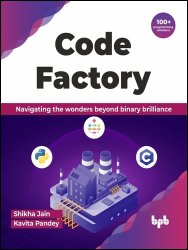Code Factory: Navigating the wonders beyond binary brilliance with 100+ programming solutions
- Добавил: literator
- Дата: 29-06-2024, 13:27
- Комментариев: 0
 Название: Code Factory: Navigating the wonders beyond binary brilliance with 100+ programming solutions
Название: Code Factory: Navigating the wonders beyond binary brilliance with 100+ programming solutionsАвтор: Shikha Jain, Kavita Pandey
Издательство: BPB Publications
Год: 2024
Страниц: 394
Язык: английский
Формат: epub (true)
Размер: 10.1 MB
Beginners in the programming world often wander to get some essential books to learn logic building with the help of algorithms, flowcharts, and minor C/Python language code. Addressing this demand, the book features over 100 solved programming questions thoughtfully arranged in incremental order of difficulty. The main objective of the book is to trigger and nurture logic-building skills among the students.
The book is structured to introduce concepts gradually, ensuring a smooth learning curve. This guide gets you ready for any programming challenge, starting from simple input/output to tackling complex problem-solving. Learn decision-making with if-else, automate with loops, and understand logic using Python and C examples. Master algorithms, flowcharts, and creative thinking. Apply your skills to real-world problems and turn them into solutions.
This book will help the readers develop a well-rounded skill set covering flowcharts, algorithmic thinking, and practical implementation in both C and Python languages. It will provide a holistic foundation for anyone aspiring to become proficient in coding.
Chapter 1: Simple Input Output Program – It provides a comprehensive understanding of the fundamental concepts and techniques involved in handling input and output operations in programming. It aims to offer a thorough comprehension of fundamental algorithms flowcharts and Python and C code implementations. These programs help users grasp crucial concepts, including user input, data manipulation, and result display. Consider this chapter a foundational step for constructing more intricate applications in subsequent book sections.
Chapter 2: Conditional Statements – It covers the concept of decision statements( if-else), elucidating them through flowcharts, algorithms, and coding. Using numerous examples, it has effectively illustrated the various facets of conditional statements such as simple if, if-else, if-else if-else, and so on. Decision statements enable the execution of specific code blocks based on certain conditions. They provide the logic for making choices within a program, making them a fundamental building block.
Chapter 3: Simple Loops – It discusses the basic loop statements such as while-loop and for-loop. In programming, a loop is a fundamental control structure that allows you to execute a block of code repeatedly as long as a specific condition is met. Loops are essential for automating repetitive tasks, iterating over certain statements, and performing various computational tasks efficiently. It optimizes the code as well. Overall, the chapter underscores the significance of loops as essential tools for improving code automation and computational efficiency in programming...
Contents:
Скачать Code Factory: Navigating the wonders beyond binary brilliance with 100+ programming solutions
Внимание
Уважаемый посетитель, Вы зашли на сайт как незарегистрированный пользователь.
Мы рекомендуем Вам зарегистрироваться либо войти на сайт под своим именем.
Уважаемый посетитель, Вы зашли на сайт как незарегистрированный пользователь.
Мы рекомендуем Вам зарегистрироваться либо войти на сайт под своим именем.
Информация
Посетители, находящиеся в группе Гости, не могут оставлять комментарии к данной публикации.
Посетители, находящиеся в группе Гости, не могут оставлять комментарии к данной публикации.

